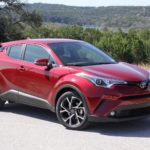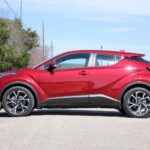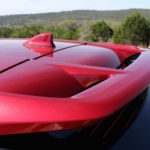Mainstream automakers are chained to the beast they helped create. Crossovers, the new automotive currency, have saturated every corner of the market in an appeal to consumers of all demographics. Americans can’t get enough, and manufacturers can’t build them fast enough.
Unfortunately, while some companies successfully adapt their personalities to the crossover segment, others seem to be jamming a square peg in a round hole, resulting in products that just don’t make sense. Reaching a new audience requires risk, and only with clear direction will the gamble pay off.
Such is the tumultuous market into which the 2018 Toyota C-HR enters. The “Coupe High Rider” is uncharted territory for a traditionally conservative Japanese brand. Bold aesthetics in a sub-compact body would have been perfect for Toyota’s youth-oriented – yet shuttered – Scion brand, but the C-HR is too late to rescue that damsel.
With a number of competitor crossovers already on sale, the C-HR faces an uphill battle to earn Toyota new market share. To stand any chance, its out-there looks must be backed by class-leading technology, fuel economy, and versatility. Is the C-HR a square peg or the perfect fit?
Filling the senses
Toyota says it’s happy to sell the C-HR to other demographics, but the vehicle has been designed expressly with Millennials in mind. The world of focus groups, surveys, and field trials is a mysterious one, but Toyota’s market research division has evidently concluded that young buyers want conspicuous cars.
The 2018 Toyota C-HR is nothing if not audacious. Each body panel has been contorted, sliced, and folded. The design is less cohesive than a Miami Beach block. Toyota points to its “distinctive diamond” styling cue as the glue for the overall C-HR aesthetic, but that feels more like an excuse for the vehicle’s creases than anything. It’s all over the place…and yet, somehow, it works. By all accounts, a mass-market entry-level crossover shouldn’t be this bold. Forgetting its place, however, the C-HR and its frenetic styling is refreshing.
At the front, the C-HR is characterized by a triangular snout, slender headlights with LED daytime running lights, and slanted lower air intakes. Standard 18-inch wheels are by far my favorite rim designs in the segment and sit well within the C-HR’s flared wheel arches. In profile, the crossover really does look like a coupe thanks to its low-slung stance, sharply raised C-pillar, and floating roofline. The rear features Honda Civic-esque C-shaped taillights, a trunk-mounted spoiler, and perhaps a bit too much black cladding on the lower bumper.
Toyota will offer R-Code edition models with a white roof that contrasts three body colors: Blue Eclipse Metallic, Ruby Flare Pearl, and Radiant Green Mica. On a different car, the white top might be gimmicky, but the C-HR’s design embraces the accent.
Without a crystal ball (mine’s still in storage), I can’t tell you if the C-HR’s styling will age well, but for now, it’s one of the most eye-catching shapes on the road.
Dynamically confusing
Beyond its futuristic looks, Toyota’s C-HR suffers from a case of mistaken identity. The Japanese automaker says it honed the new crossover’s driving dynamics on the Nurburgring, yet the average Millennial has probably never heard of such a place.
The C-HR shares its platform with Toyota’s latest Prius. The TNGA (Toyota New Global Architecture), which will underpin several new models in the coming years, is fantastic – especially for a non-performance vehicle. The C-HR’s low center of gravity and stiff platform pair well with its MacPherson strut front suspension and double-wishbone rear suspension to control a portly 3,300 pounds. To my immense surprise, the C-HR handles just as well or better than Mazda’s CX-3 – the sub-compact crossover segment’s dynamic benchmark.
More: The 5 Best Crossovers You Can Buy Right Now
Equally surprising is the C-HR’s steering. Electric steering racks are a tricky thing – overboosted systems are twitchy and annoying, but overly dulled calibrations are just as bad. Toyota dialed in its steering system almost perfectly – my only knock is that inputs take a split second to process before the vehicle responds as instructed.
Alas, these two highlights are muddled by an anemic powertrain. The 2018 C-HR will ship with one powertrain and one transmission. A 2.0-liter four-cylinder and CVT (continuously variable transmission) combination delivers 144 horsepower and 139 pound-feet of torque to the front wheels. All-wheel drive is not an option. In a lighter body, this might be an acceptable output, but the C-HR feels downright slow when prodded. Around town, the lack of grunt is hardly noticeable, but at highway speeds, the crossover wheezes along.
“Wait,” you might reason, “surely Toyota has done this to produce strong fuel economy numbers.” Sadly, no. The C-HR returns 27 mpg in the city, 31 on the highway, and 29 combined. These figures are merely acceptable for a compact, front-wheel drive crossover. For comparison, the Honda HR-V gets 31 combined and the (far more powerful) Nissan Juke gets 30.
The C-HR’s handling is certainly impressive, but a lackluster powertrain doesn’t exactly beg to be pushed.
Techno-flop
If I stop the review here, you might (reasonably) consider the C-HR a competitive subcompact crossover, but there’s one big, glaring problem: Toyota forgot the technology. In other words, the Millennials Toyota cares so much about are not going to be happy.
Toyota has nailed one aspect of the C-HR’s innovation: safety features. Families will be pleased to hear that Toyota’s robust suite of safety technologies (Toyota Safety Sense) comes standard on the C-HR. That means pre-collision warning with active braking, lane departure warning with steering assist, dynamic cruise control, and adaptive high beams are part of the base trim’s $22,500 package. This safety bundle isn’t just good for the segment – it’s unmatched. Specifically, pre-collision and dynamic cruise control (which works all the way to 0 mph) isn’t even offered on rivaling entry-level crossovers.
However, these safety features face a major design flaw: the C-HR’s rearward visibility is atrocious. That edgy C-pillar may look cool, but it also becomes a giant blind spot for the driver. A narrow rear window compounds the problem; getting a clear look in any direction except forward is extremely difficult. XLE Premium models give drivers a chance with standard blind spot monitoring, but base XLE models can be downright dangerous. Yet another conflicting move is Toyota’s decision to put the (standard) backup camera in the rearview mirror. Instead of putting the camera view into the 7.0-inch infotainment system, Toyota attempts to show a wide field of rear view in a tiny embedded screen.
More: Toyota Prius Prime First Drive
Speaking of the 7.0-inch infotainment system, it might as well be dead space. The low-resolution touchscreen can be used to access AM/FM/HD Radio, Bluetooth, the Aha music app, and iPod connectivity. Apple CarPlay and Android Auto aren’t available, nor is Sirius XM. There’s also a single USB port in both the XLE and Premium grades. Toyota won’t impress any tech-savvy shoppers with this level of connectivity.
The rest of the interior is equally underwhelming. You can choose from several exterior colors, but the cabin only comes in black and the seating surfaces are cloth in both trims. Apart from a couple high-quality touch points like the leather-wrapped steering wheel and a soft-textured dashboard, it’s a tale of hard plastics and wasted storage space.
Needs improvement
Tallying up the 2018 C-HR’s strengths and weaknesses, it appears Toyota doesn’t fully understand its target market. Innovative styling is cut at the knees by a lack of segment-competitive connectivity, and stellar safety technology is countered by horrendous interior visibility. Millennials (myself included) may be tough to understand, but skipping connectivity features is a clear no-no.
The C-HR’s one saving grace may be its price tag. At $22,500, the XLE comes with a number of standard styling features that will resonate with a particular buyer. Those who can see past the C-HR’s flaws to gain trend-setting design have their crossover mate. Everyone else has a number of more qualified options.
Highs:
- Exceptional handling
- Unique, eye-catching styling
- Segment-leading safety features
Lows:
- Lackluster powertrain
- Poor visibility
- Underwhelming technology




















